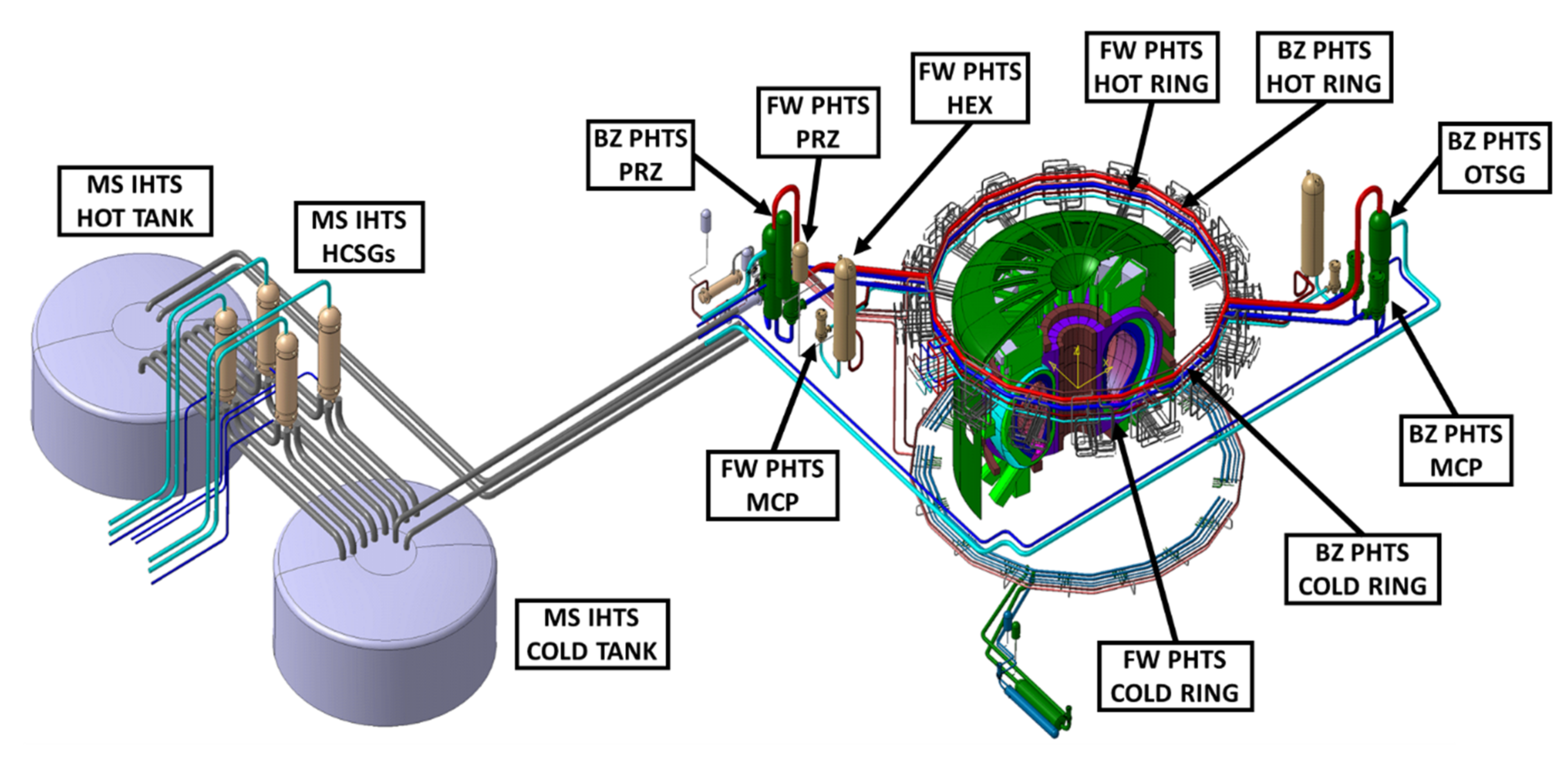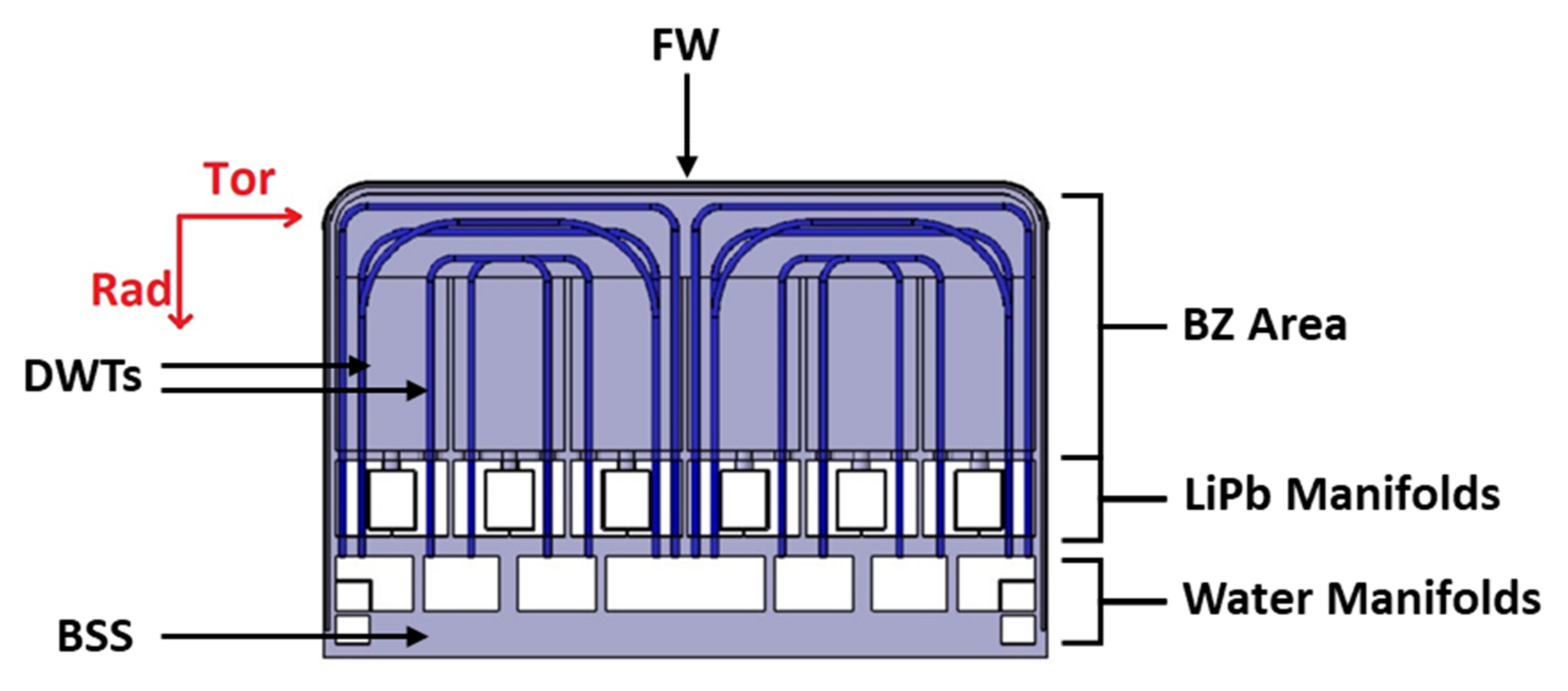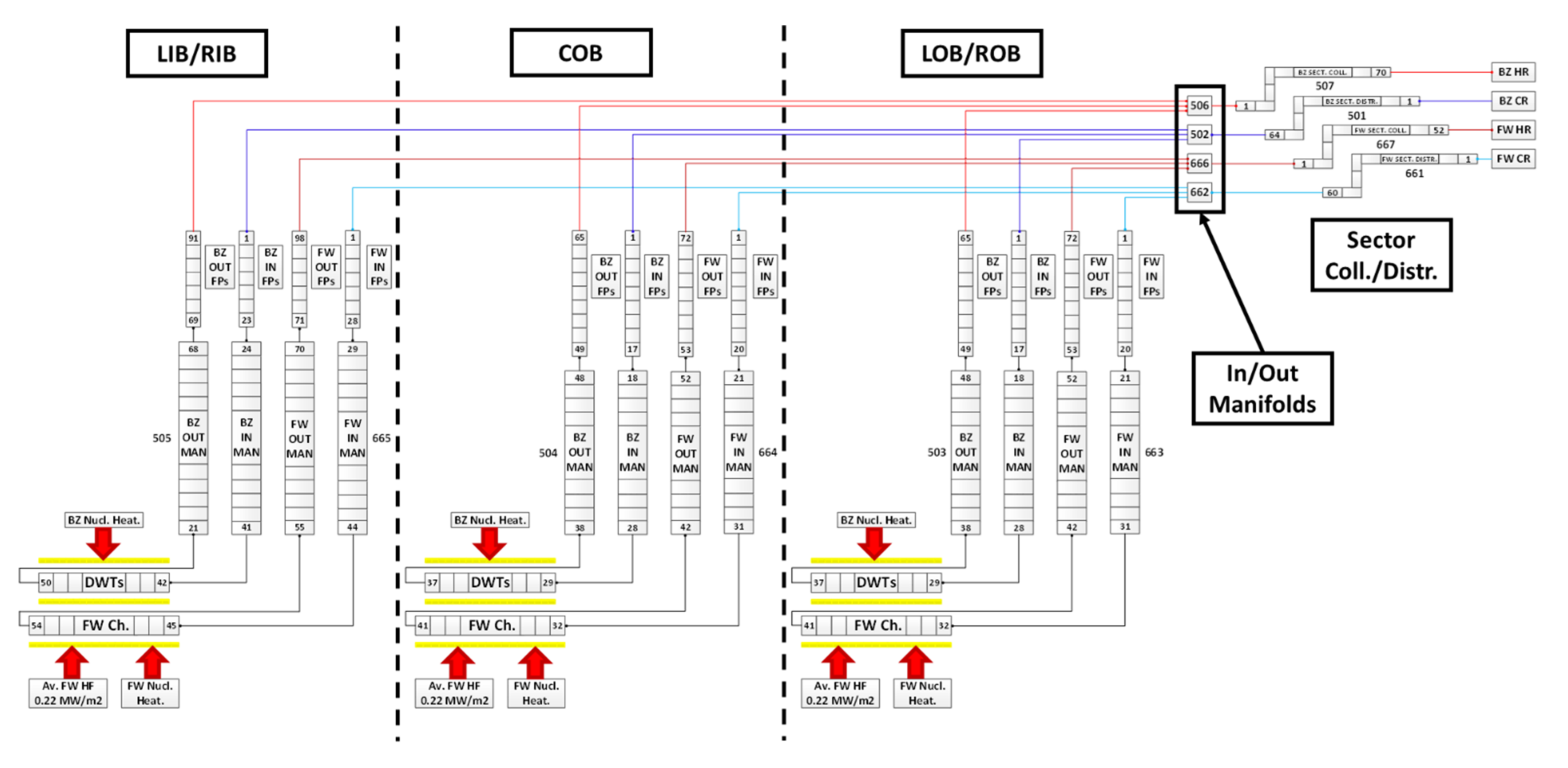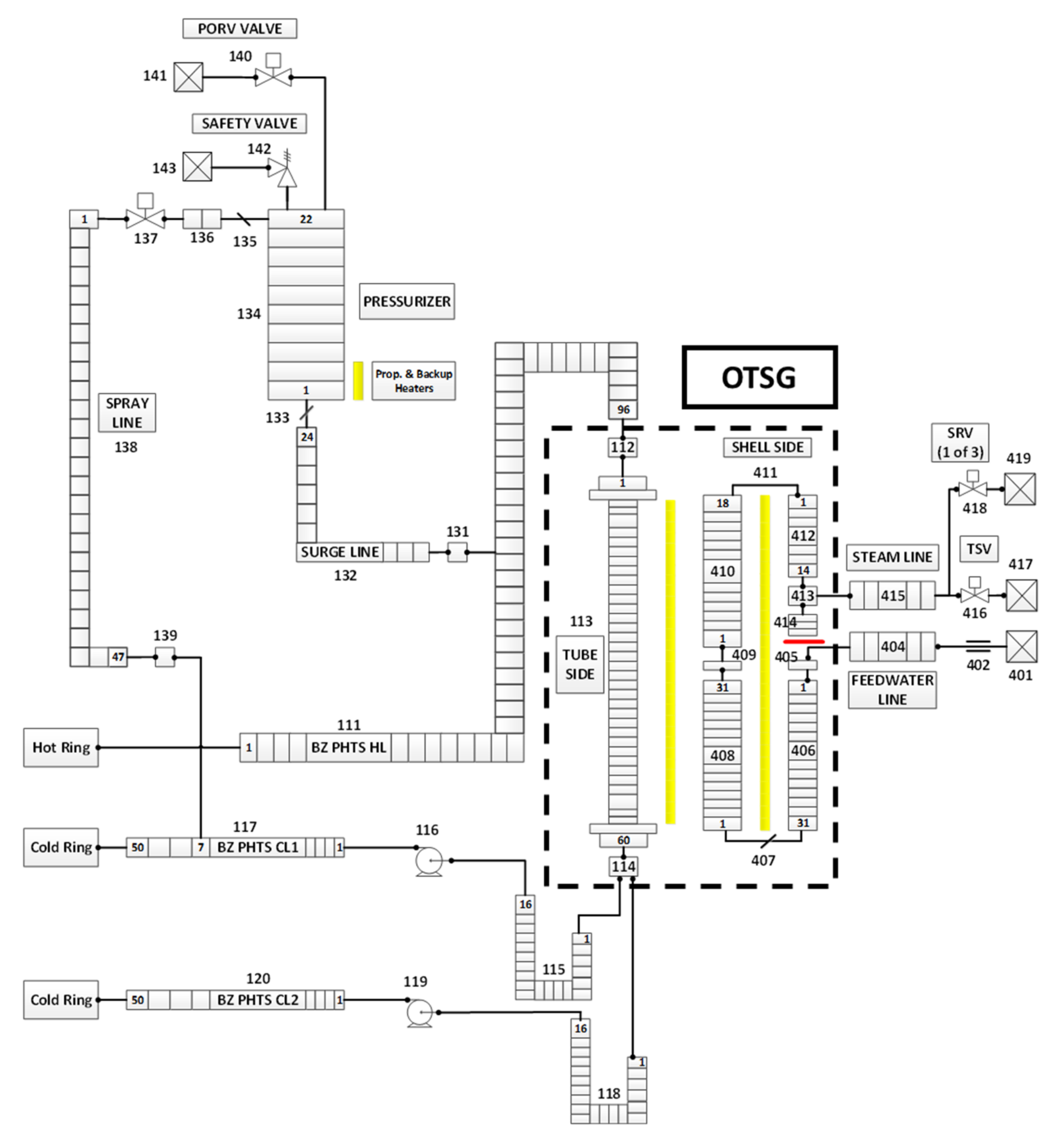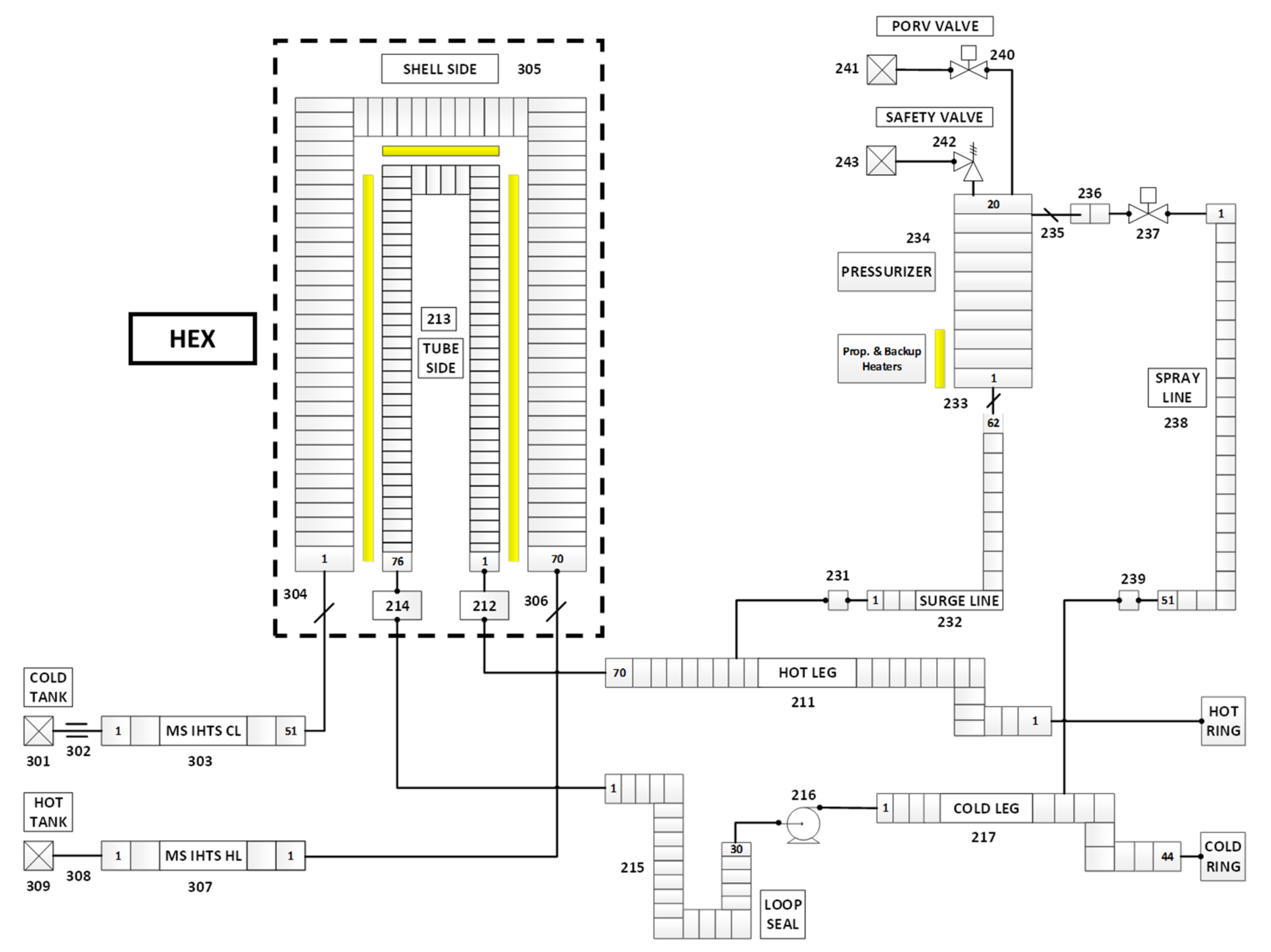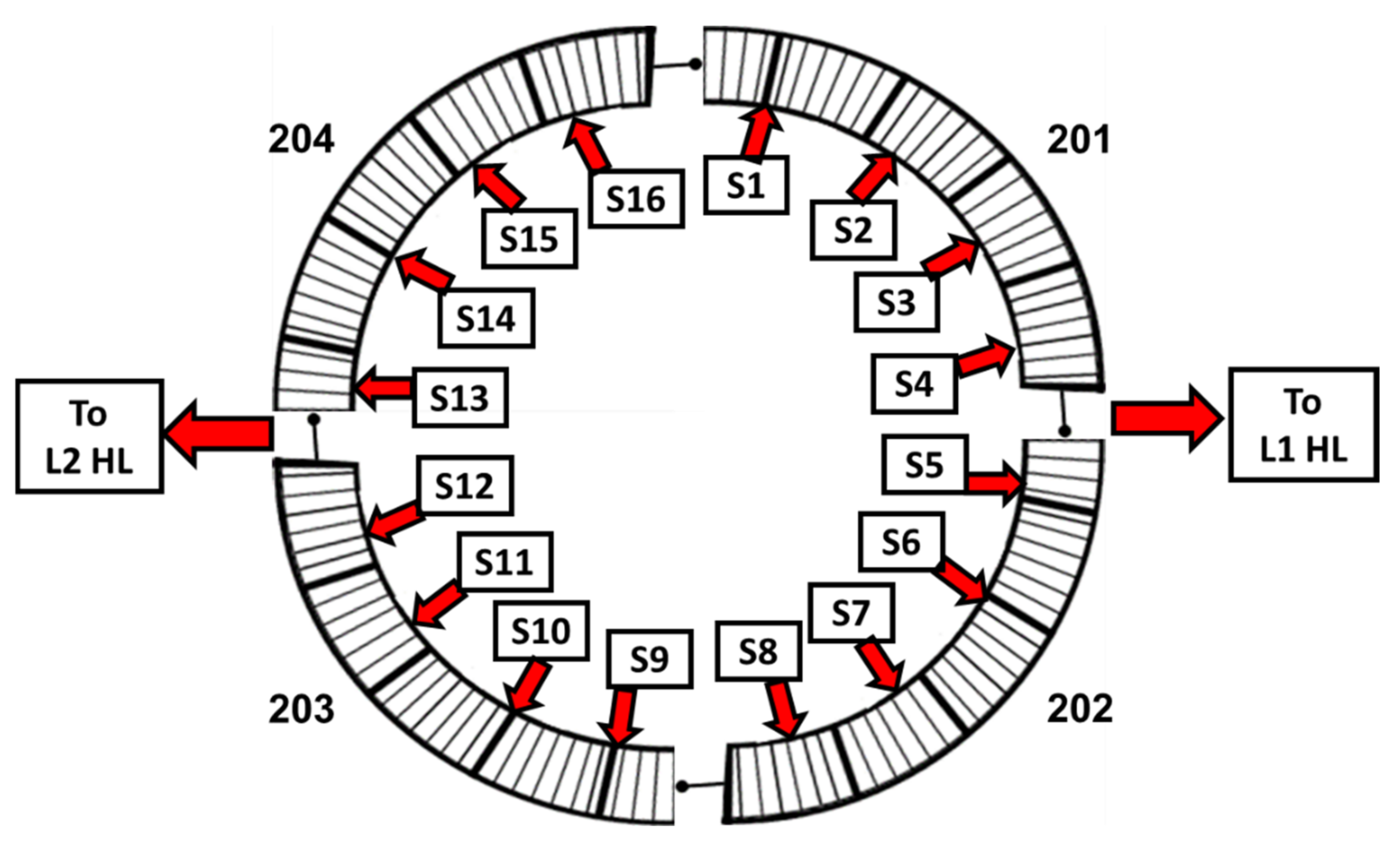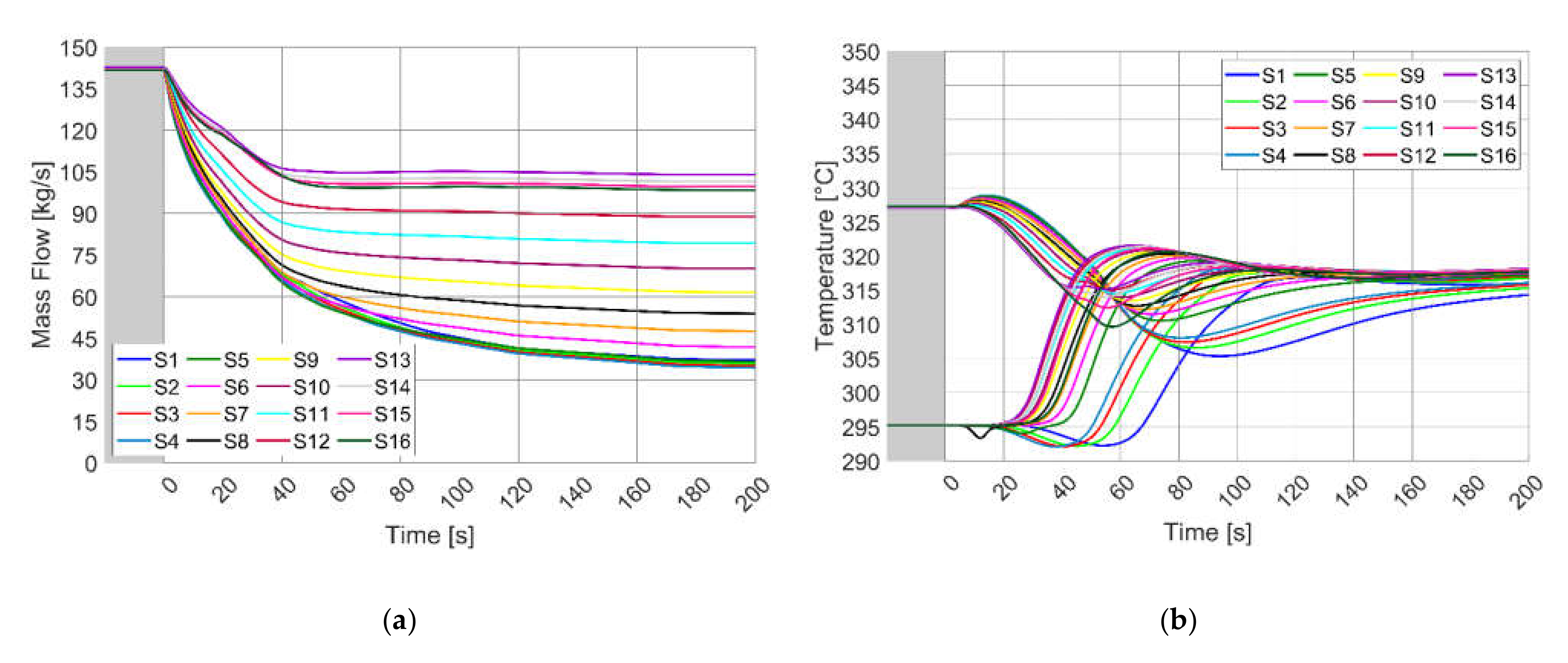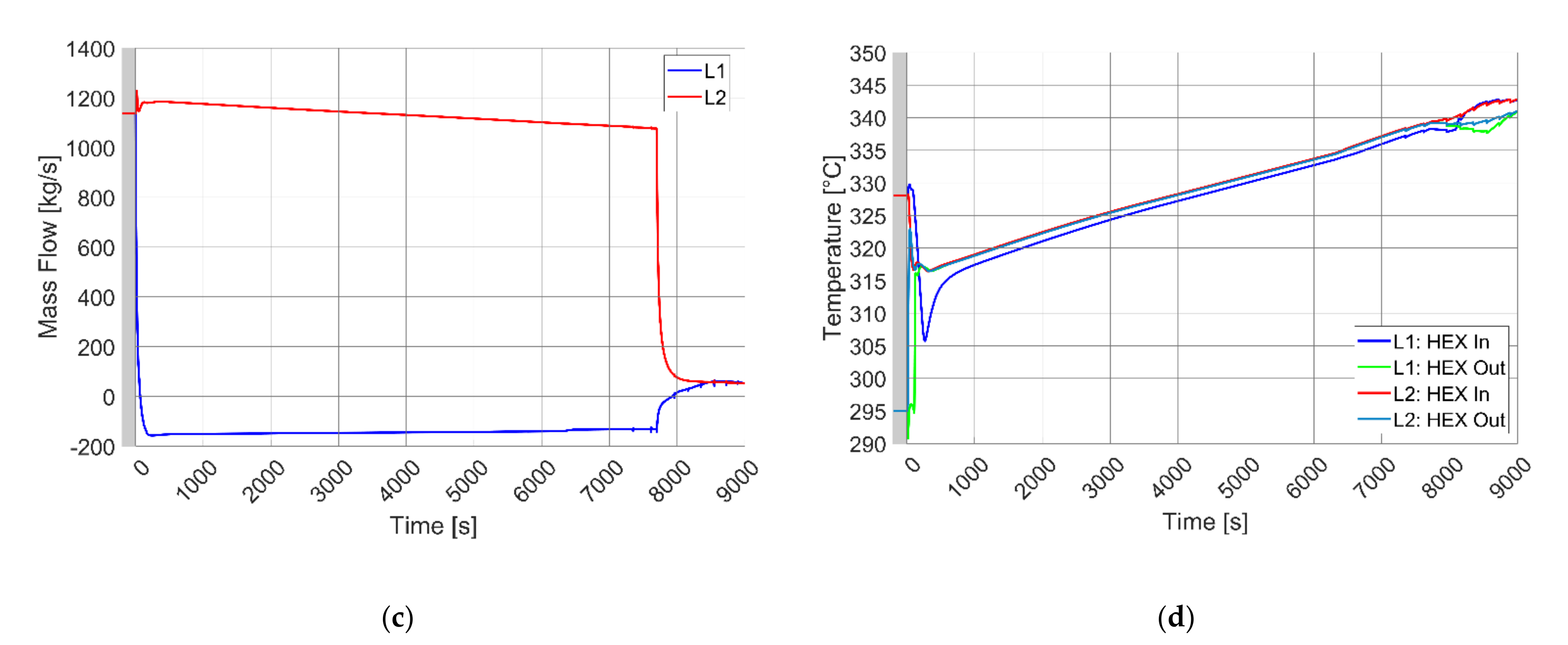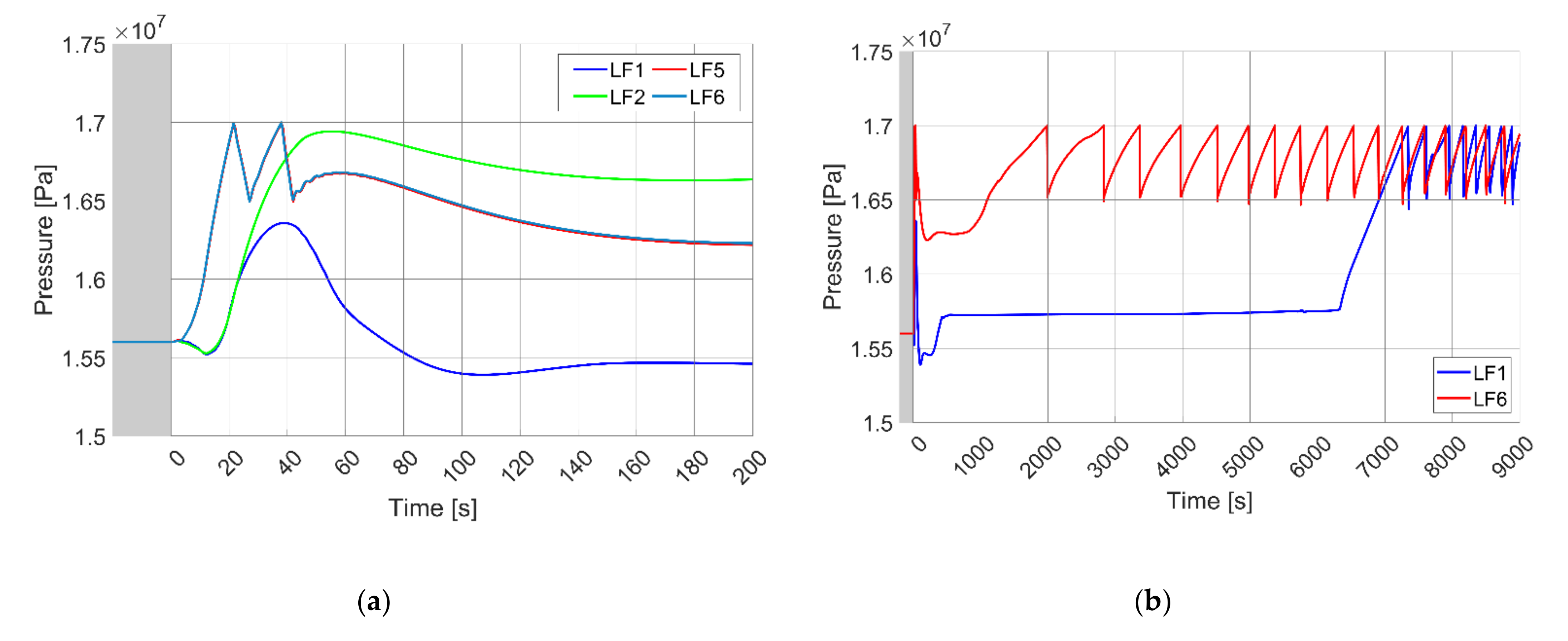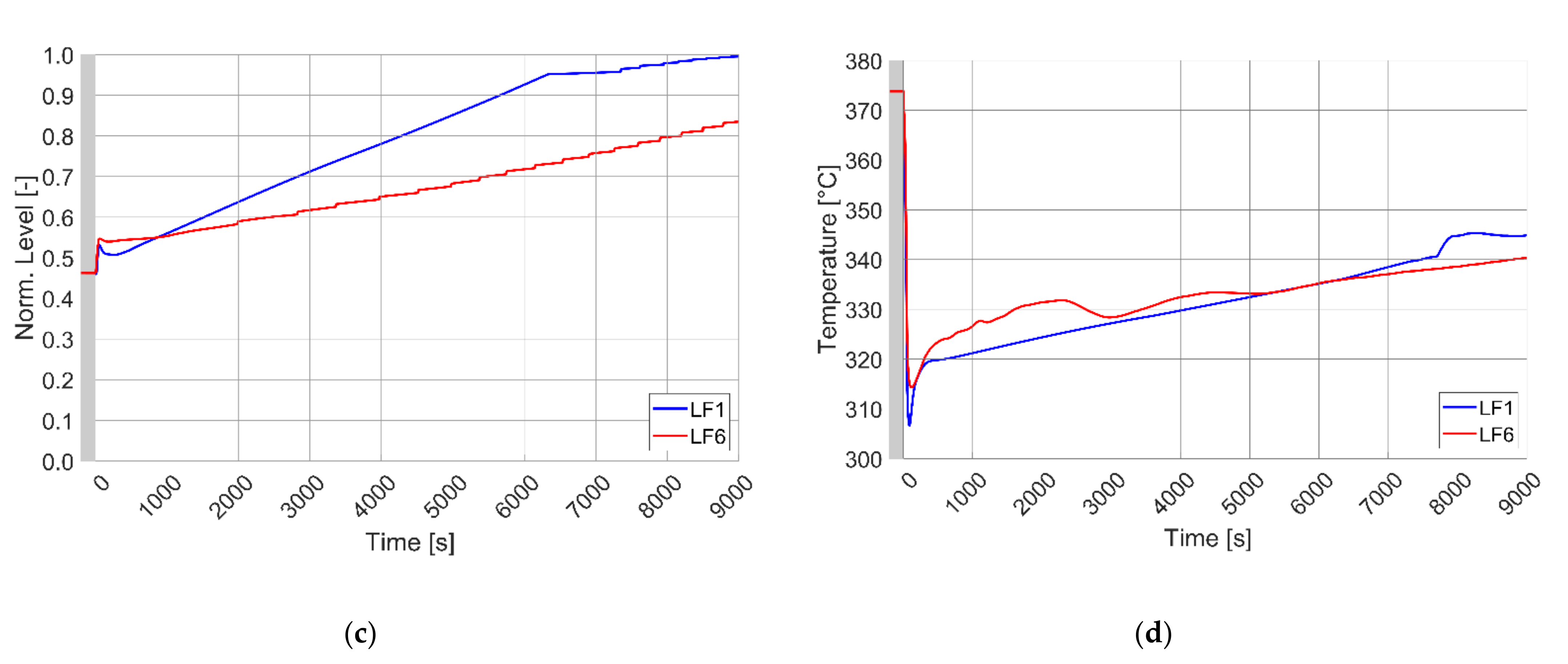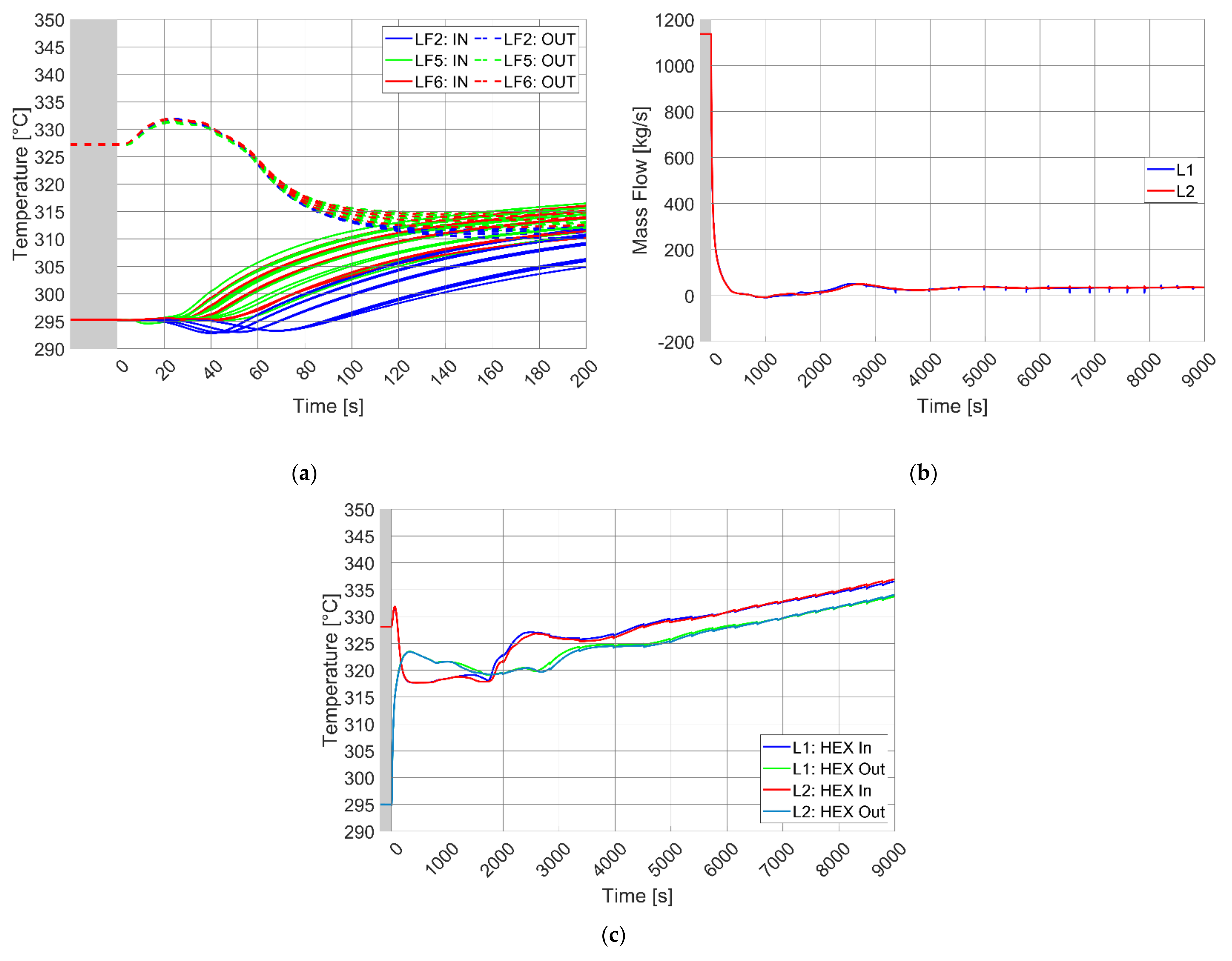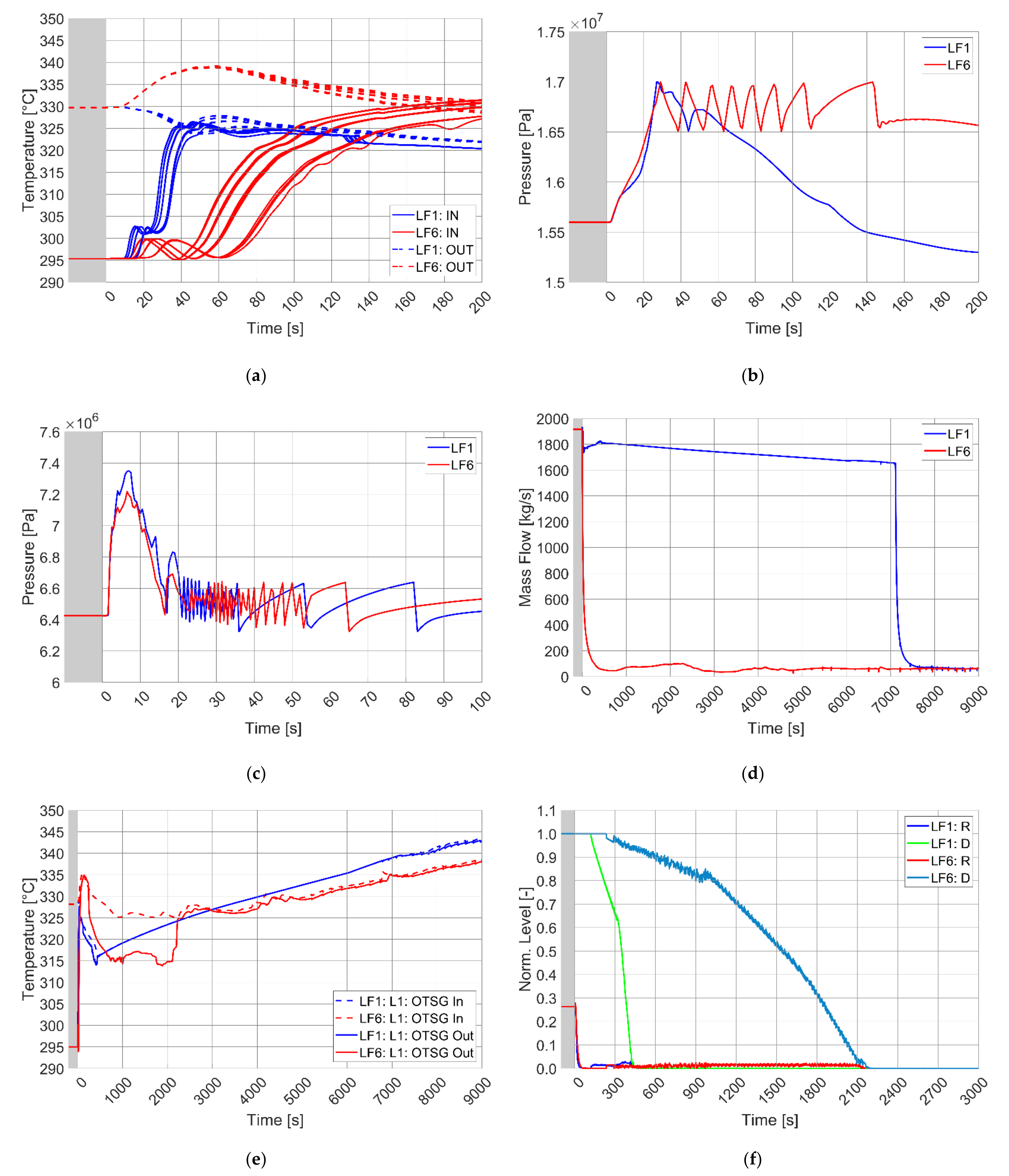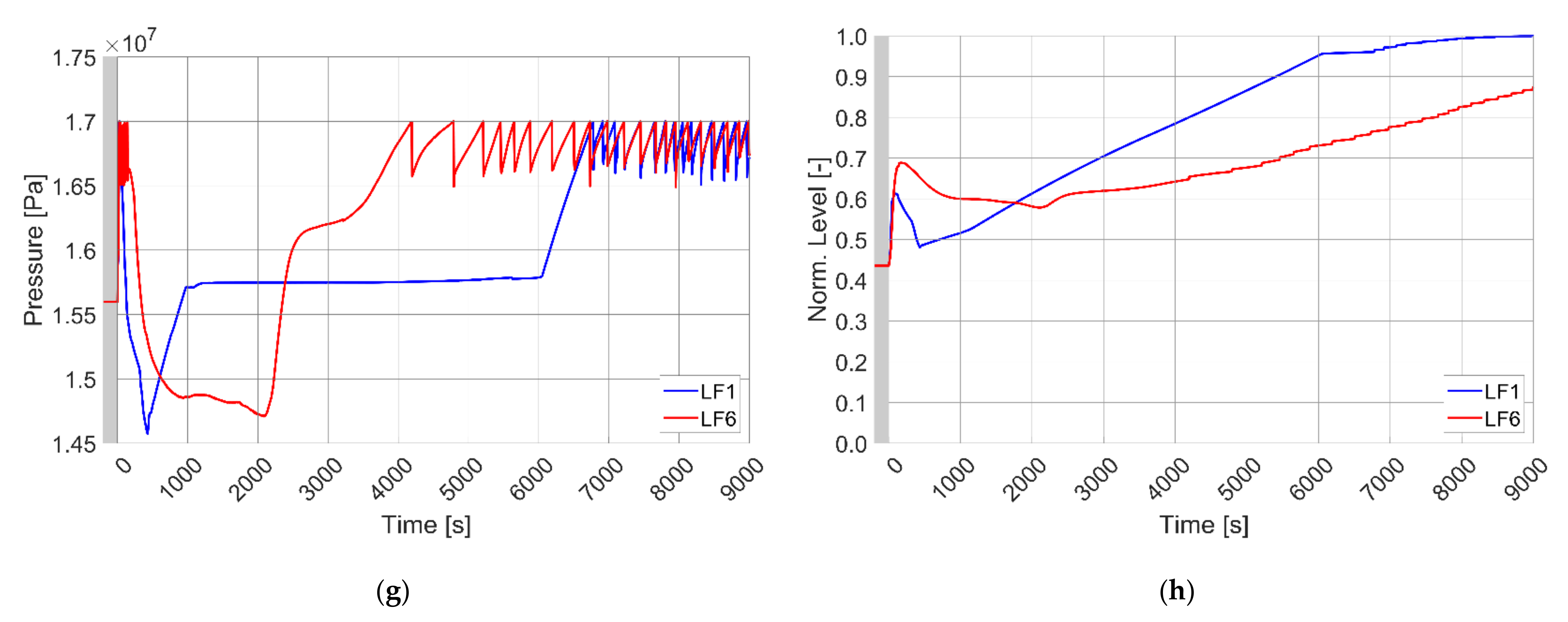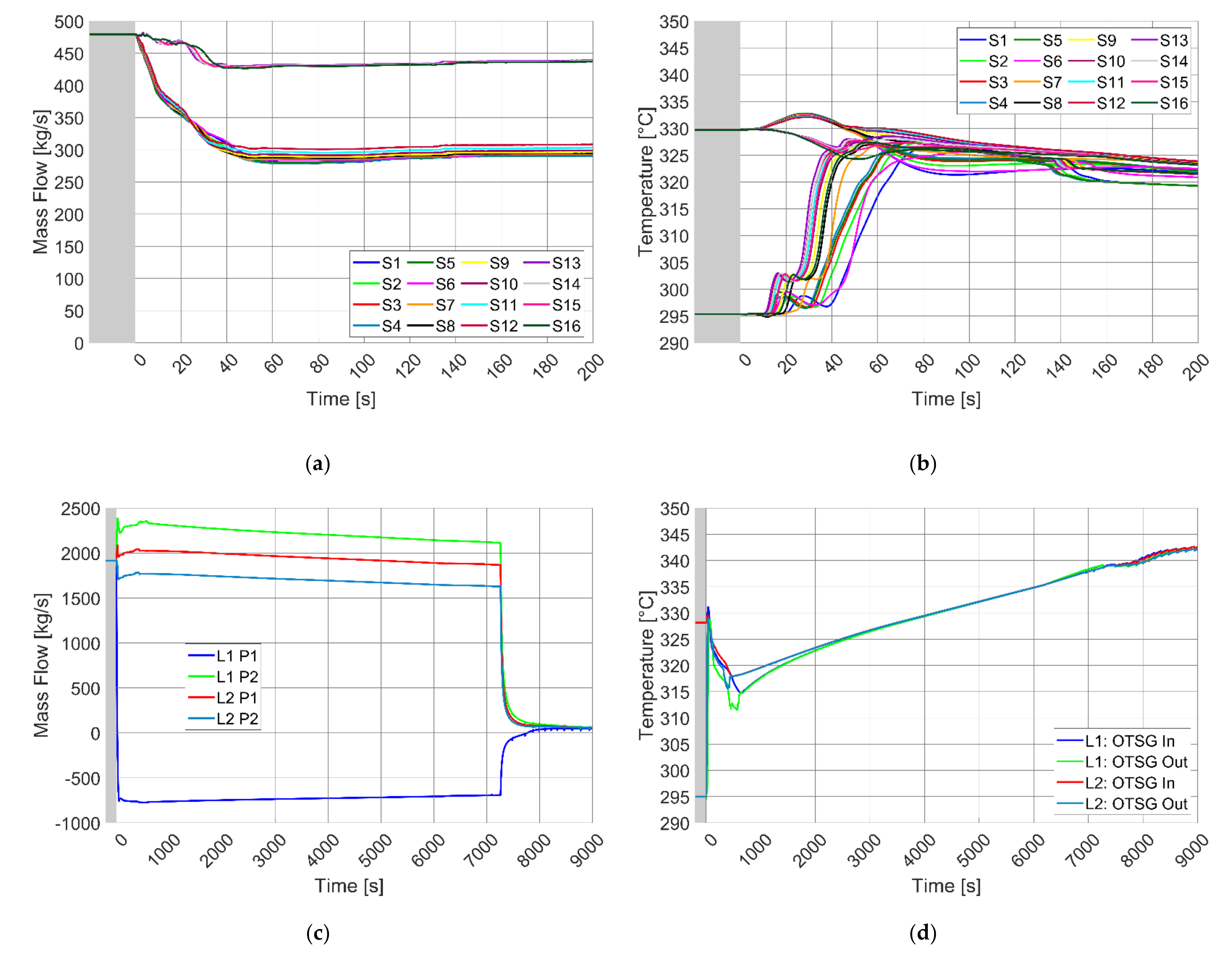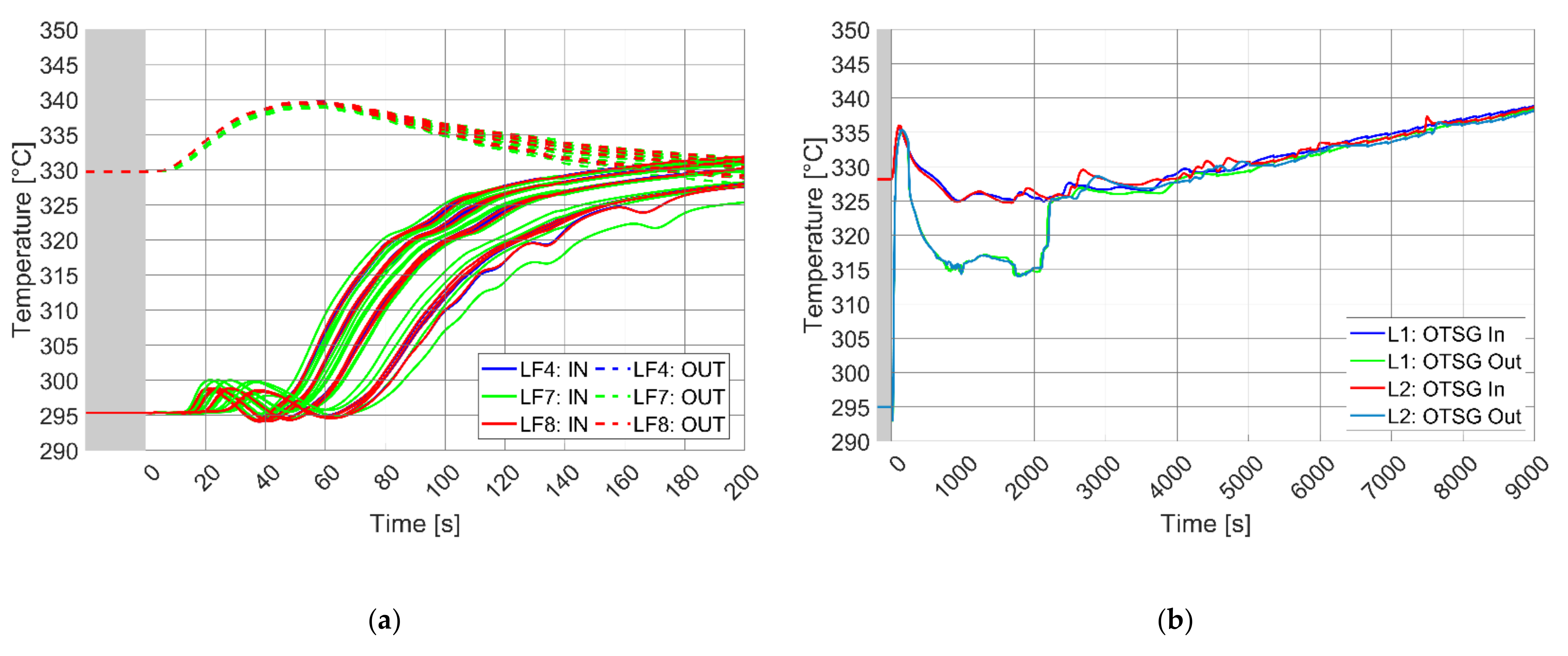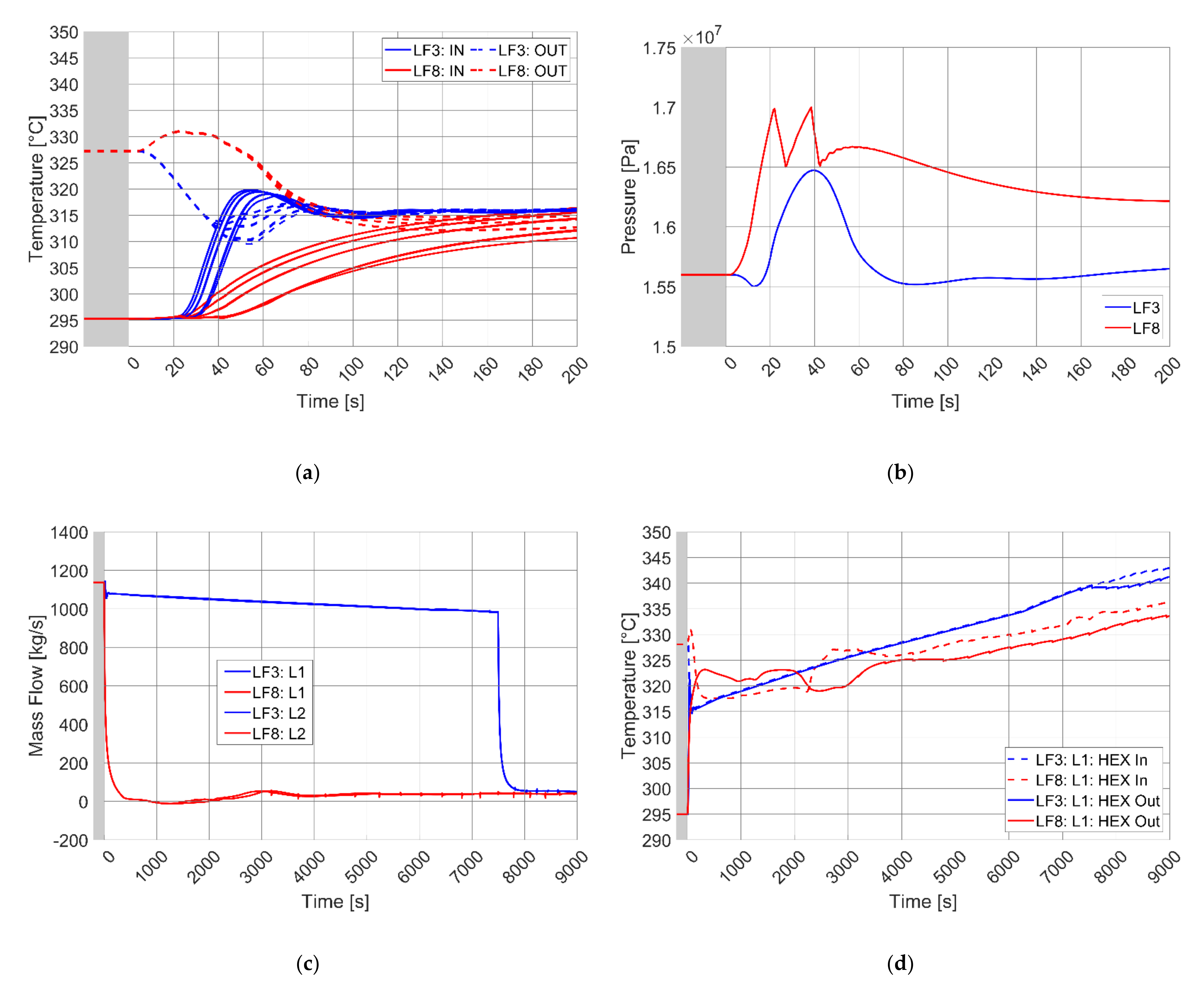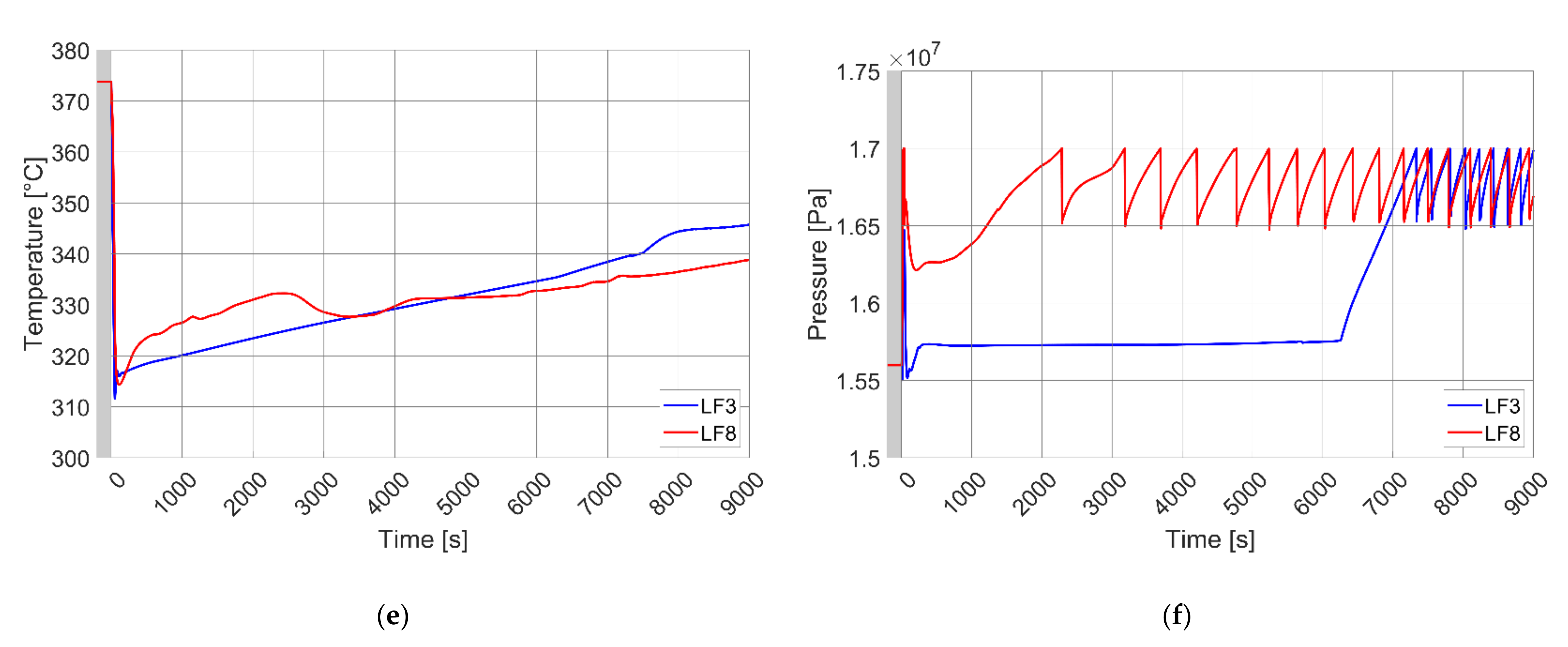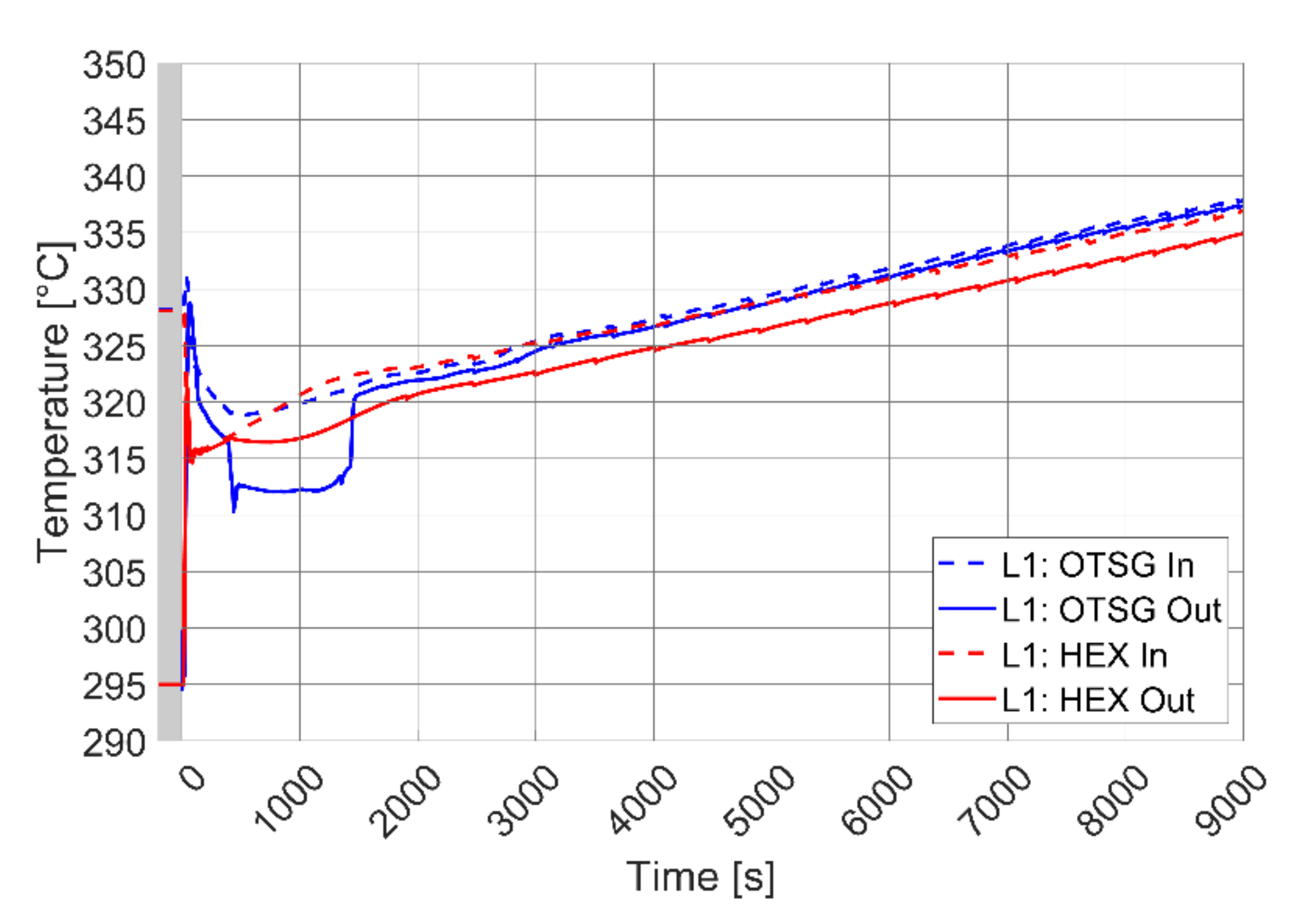1. Introduction
In the European DEMO (EU-DEMO) fusion reactor, the Breeding Blanket (BB) component accomplishes several functions [
1,
2]. Firstly, it acts as a cooling device. The nuclear interactions between the neutrons produced within the plasma and the lithium contained in the breeder allow to convert the neutron kinetic energy in thermal power to be removed. The same nuclear reactions are supposed to be used to produce the tritium fuel needed to reach the self-sufficiency. Moreover, the breeding blanket serves as shielding, preventing the high-energy neutrons from escaping outside the reactor and protecting from damage the more radiation-susceptible components, like the superconducting magnets.
In the framework of the EUROfusion Programme, two breeding blanket concepts were selected for the EU-DEMO R&D strategy: Water-Cooled Lithium-Lead (WCLL) and Helium-Cooled Pebble Bed (HCPB) [
1]. These two technologies will also be tested in the ITER fusion reactor, according to the goals of the ITER Test Blanket Module (TBM) programme [
1]. The main outcome of this experimental campaign will be the Return of Experience for the EU-DEMO Breeding Blanket Programme [
3]. The computational activity presented in this paper deals with the WCLL option. It foresees the usage of water at typical Pressurized Water Reactor (PWR) thermodynamic conditions (295–328 °C and 15.5 MPa) as coolant [
1,
2]. The blanket relies on liquid lithium-lead as breeder, neutron multiplier and tritium carrier and on Eurofer as structural material. An armour, consisting of a thin tungsten layer is assumed to cover the First Wall (FW) component (plasma-facing surface).
The cooling systems associated to the principal blanket subsystems, namely the FW and the Breeder Zone (BZ), are called Primary Heat Transfer Systems (PHTS) [
2,
4]. Their main function is to provide primary coolant at the required thermodynamic conditions. The thermal power they remove is then delivered to the Power Conversion System (PCS) to be converted into electricity [
5,
6].
With the aim of the design improvement, the evaluation of the BB PHTS thermal-hydraulic (TH) behavior during anticipated transient and accident conditions is a key issue. To achieve this goal, computational activities can be performed by using best estimate system codes. Principally, system codes adopt a one-dimensional approach to solve the balance equations. For this reason, they are more recommended for simulations involving circuits, where the fluid main stream direction can be clearly identified. They allow to simulate the overall primary cooling system, including the pipelines and all the vessel components (pumps, heat exchangers, pressurizer). However, in some of them, also 3D approaches are partially implemented, such as in RELAP5-3D [
7], CATHARE-3 [
8], SAM [
9], and so they can also be used for components characterized by more complex fluid flow paths. Throughout decades, these codes have been validated for Light Water Reactors (LWR), simulating a wide range of transient and accidental scenarios. Hence, their usage can also be envisaged for WCLL blanket, whose primary coolant has similar thermodynamic conditions.
In the last years, a large experience was matured in the simulation of transients involving fusion reactors. Referring to EU-DEMO WCLL PHTS, both the in-vessel [
10] and ex-vessel [
11] Loss Of Coolant Accidents (LOCA) were investigated with MELCOR code, [
12]. The main simulation purpose was assessing the hydrogen production and the radiological source term mobilization in order to demonstrate the consistency of the EU-DEMO design with the safety and environmental criteria. MELCOR code was also used for a parametrical study in support of the reactor Vacuum Vessel Pressure Suppression System design, as described in [
13]. A preliminary analysis of the Loss Of Flow Accident (LOFA) is reported in [
14]. In this case, RELAP5/Mod3.3 code [
15] was used to perform a TH-oriented transient calculation aimed at the sizing of the flywheel to be adopted for the PHTS Main Coolant Pumps (MCPs).
For what concerns the EU-DEMO HCPB PHTS, RELAP5-3D code was properly integrated with a computational fluid-dynamic code in order to investigate the thermal-hydraulic performances of the primary circuits during an Ex-Vessel LOCA scenario, [
16]. With the same code, multiple LOFA scenarios were also studied [
17]. LOCA transients were also simulated with MELCOR code [
18]. The activity goal was to perform a parametric study on the break size and to assess its impact on some reactor relevant parameters, such as containment pressure and FW component maximum temperature.
System codes were largely adopted also in the framework of research activities related to China Fusion Engineering Test Reactor (CFETR) and Korean DEMO (K-DEMO) Reactor. CFETR design foresees a Water-Cooled Ceramic Breeder (WCCB) blanket concept. RELAP5/Mod3.3 code was employed for transient analysis involving LOFA, [
19], and Loss of Heat Sink (LOHS), [
20], scenarios. The calculations allowed an in-depth evaluation of the WCCB blanket behavior. As initial conditions, different fusion power modes were considered.
One of the blanket concepts proposed for K-DEMO reactor is the water-cooled multiple-layer breeding blanket. It consists of a sandwich of multiple layers of breeder (Li
4SiO
4) and multiplier (Be
12Ti) mixtures, cooling channels, and structural materials. They are stacked in the radial direction, parallel to the first wall. MELCOR was adopted to investigate the reactor response after a vacuum vessel rupture, mainly focusing on hydrogen production and dust explosions, [
21].
System codes also allow to study operational transients and to conceptually design the machine control system. This is a relevant design issue for fusion reactors where a plasma pulsed operating regime is foreseen (including both pulse and dwell phases). Similar studies were conducted for all the aforementioned fusion reactor concepts: EU-DEMO HCPB, [
14], with RELAP5-3D; EU-DEMO WCLL, [
16], with RELAP5/Mod3.3; CFETR, [
22], with RELAP5/Mod3.3; K-DEMO, [
23], with Multi-dimensional Analysis of Reactor Safety (MARS-KS) [
24].
The calculations presented in this paper were performed within the framework of the EUROfusion Work Package Breeding Blanket, by using a modified version of RELAP5/Mod3.3 code, [
25]. This new extended version was developed at the Department of Astronautical, Electrical and Energy Engineering (DIAEE) of Sapienza University of Rome, in order to enhance the code capability in simulating fusion reactors. New features implemented include new working fluids (lithium-lead, HITEC
® molten salt), new heat transfer correlations, etc. The selected transients to be investigated belong to the category of “Decrease in Coolant System Flow Rate”. The considered Postulated Initiating Events (PIE) consist in both the partial and complete LOFA occurring either in BZ or in FW PHTS. In addition, the influence of the loss of off-site power, occurring in combination with PIE, was studied.
In the following,
Section 2 offers a brief description of EU-DEMO WCLL reactor configuration. In
Section 3, it is described the RELAP5/Mod3.3 model developed to simulate the blanket component and the related primary heat transfer systems. Calculation results are collected in
Section 4. Full plasma power state is commented in
Section 4.1, while transient simulations are fully analyzed in
Section 4.2. A final discussion on the main outcomes of the computational activity is reported in
Section 5. The conclusive remarks related to the current work are contained in
Section 6. Moreover, at the end of the paper, it is provided a list of the main acronyms used in the text.
2. Short Overview of EU-DEMO WCLL Reactor Configuration
DEMO reactor normal operations are characterized by a pulsed operating regime. It consists in eleven pulses per day, each one made up of a full-power burn time (pulse) of two hours and a dwell time of 10 min [
6]. The reference parameters and baseline are those of DEMO 2017 concept [
2]. The reactor Computer Aided Design (CAD) model is shown in
Figure 1 [
2,
4,
5], including all the PHTS components located inside and outside the Vacuum Vessel.
The reference design adopted for DEMO blanket is the WCLL2018.v0.6, based on Single Module Segment (SMS) approach [
2,
4]. The overall component is constituted by 16 identical sectors, each one occupying 22.5° in the toroidal direction. Each sector is furtherly divided in In Board (IB) and Out Board (OB) blankets, located radially inwards and outwards with respect to the plasma chamber. At its time, OB is toroidally composed by 3 SMSs named Left OB (LOB), Central OB (COB) and Right OB (ROB), while IB is partitioned only in two SMSs, called Left IB (LIB) and Right IB (RIB). In conclusion, five segments are associated to each DEMO sector.
Each single segment is made up of about 100 breeding cells (BRC), distributed along the poloidal (vertical) direction. The BRC layout is differentiated between segments (especially between OB and IB segments) and, in the same segment, varies according to the poloidal position. The BRC design used as reference for modelling purposes is the one of the COB equatorial cell. Its detailed description can be found in [
26,
27]. In the BRC, the component facing the plasma chamber is called First Wall (FW). It is protected by a tungsten armor and cooled with water flowing in square channels equally distributed along the poloidal height. The liquid lead-lithium (LiPb) acts as breeder. It enters the BRC from the bottom, flows in the radial direction, from the BRC Back Plate (BP) to the FW, rises poloidally and then turns back radially, from the FW to the BP, exiting through an outlet pipe. The breeder zone refrigeration is assured by a batch of radial-toroidal C-shaped Double Walled Tubes (DWTs). They are displaced in horizontal planes at different poloidal elevations and are split into three arrays along the radial direction. In this way, their cooling capability is uniformly distributed in all the BZ volume. The back part of the breeding cell in the radial direction is devoted to house both LiPb and water manifolds. Finally, the back supporting structure is a continuous steel plate in poloidal direction representing the backbone of the blanket segment. The layout for COB equatorial cell is shown in
Figure 2 [
2,
4].
The blanket component is provided with two independent cooling systems: the BZ PHTS and the FW PHTS. The former removes the nuclear heat generated in the breeder zone by the interactions between the lead-lithium and the neutrons coming from the plasma. The latter cools the FW component which is heated up by the incident Heat Flux and by the neutron wall load. The simulation activity presented in this paper is related to the indirect coupling option [
4,
6]. In this configuration, the BZ PHTS delivers thermal power directly to the PCS, by means of two Once-Through Steam Generators (OTSG). Instead, the FW PHTS, thanks to two water/molten salt Heat EXchangers (HEXs), is connected to an Intermediate Heat Transfer System (IHTS) provided with an Energy Storage System (ESS). The ESS function is to flatten the pulsed source term (plasma power), according to the design requirement of continuous and nearly constant electrical power delivered to the grid. The ESS accumulates a fraction of the FW thermal power during the plasma pulse and delivers it to the PCS during the dwell time. The power fraction to be accumulated during pulse is calculated to obtain a constant turbine load during the overall operating regime (pulse and dwell). The energy storage is constituted by a system of two tanks filled with molten salt at different temperatures. During pulse, there is a net HITEC
® flow rate going from the cold tank to the hot one and here accumulated. During dwell, the hot molten salt flows through four Helicoidal Coil Steam Generators (HCSGs) and power is delivered to the PCS. The current PHTS design foresees two loops for each system. They are symmetrically disposed along the tokamak circumference (i.e., toroidal direction). The main PHTS components (for both BZ and FW cooling circuits) are:
The hot and cold rings, circular collectors (hot) and distributors (cold) of the overall PHTS mass flow from/to the loops and to/from each of the tokamak sectors, respectively.
The sector manifolds, differentiated in collectors and distributors, respectively connecting the tokamak sectors to the hot ring and the cold ring to the tokamak sectors.
The loop piping (hot legs, cold legs, loop seals), linking the main vessel components.
The BZ OTSGs and the FW HEXs.
The MCPs, providing the primary coolant flow.
The pressurizer system, one per PHTS, ensuring the pressure control function.
The location of each component in the overall cooling systems is shown in
Figure 1. For modelling purposes, the PCS and IHTS system sections considered are only the BZ OTSGs and FW HEXs secondary sides.
3. RELAP5 Thermal-Hydraulic Model
Referring to the reactor configuration outlined in the previous section, a full model of the DEMO WCLL BB PHTS was prepared to perform transient calculations. The main modelling approach considered while developing the input deck was the “slice nodalization” technique. This means that a common vertical mesh was used for all the system components at the same elevation. In addition, the node-to-node ratio, defined as the ratio between the length of two adjacent control volumes (CVs), was kept below 1.25 in the entire model. The respect of this upper limit represents an important criterion to avoid numerical errors due to an inhomogeneous mesh. For all the vessel components and piping, actual design elevations were strictly maintained to avoid inconsistencies mainly in the evaluation of the natural circulation. Fluid and material inventories were rigorously maintained for both BB and PHTS cooling systems.
3.1. Blanket Model
From the hydrodynamic point of view, the BZ and FW cooling circuits were independently simulated. Nevertheless, the two systems are thermally coupled inside the BRC. For this, RELAP5 heat structure components were used to simulate in detail the heat transfer phenomena taking place within the breeding cell. During transient simulations, the BZ and FW thermal coupling has a significant influence on the circuit TH behavior.
As already pointed out, each DEMO sector is constituted by five poloidal segments (three for OB and two for IB). The BZ and FW cooling circuits here contained were collapsed in some equivalent pipe components, three for each PHTS. The OB and IB segments were grouped as following: LOB/ROB, COB, LIB/RIB.
For both BZ and FW PHTS, the equivalent pipes model the overall water flow path inside the vacuum vessel. The components associated to each segment and considered for simulation purposes are: (1) inlet Feeding Pipe (FP); (2) inlet spinal water manifold; (3) DWTs or FW channels; (4) outlet spinal water manifold; (5) outlet FP. The CVs belonging to the equivalent pipes are characterized by different hydraulic properties (flow area, hydraulic diameter, etc.) in order to properly simulate all the aforementioned components. For the equivalent pipes corresponding to LOB/ROB and LIB/RIB, the CVs flow area and hydraulic diameter, as well as the water mass flow, were evaluated considering the reference data belonging to both segments. In this way, the pressure drops through these components were correctly modelled. The PHTS sector collectors and distributors, mentioned in
Section 2, are connected to the FPs thanks to inlet and outlet manifolds, closing the overall PHTS circuit. In conclusion, for each PHTS (either BZ or FW) and for each sector, five equivalent pipes and two branches were used. Pipe components correspond to: sector distributor (P1); water circuit inside LOB and ROB (P2); water circuit inside COB (P3); water circuit inside LIB and RIB (P4); sector collector (P5).
Regarding the BRC, the most studied design belongs to the cell located at the equatorial plane of COB [
2,
26,
27]. For this reason, it was adopted as reference and also used for all the other BRCs poloidally distributed along the overall segment. Concerning the BRCs of ROB, LOB, LIB, RIB segments, the reference layout was scaled by using the material inventories derived from the CAD model [
2,
4,
5].
About the DWTs, since these components are in parallel within the BRC, they were collapsed and modelled by using the central batch of CVs of P2, P3, P4 equivalent pipes, the ones related to BZ PHTS. As discussed in
Section 2, they are split into three arrays along the radial direction. Moreover, their C-shape in the radial-toroidal plane changes according to the array they belong to [
26,
27]. The complexity of the geometry requires the choice of a reference DWT layout. For this purpose, the second array was selected, that is the mid-one along the radial direction. It was considered sufficiently representative of the average geometrical features of all the DWTs present in the BRC.
BZ and FW inlet/outlet spinal water manifolds consist in rectangular channels running along the back of the segment, radially inwards with respect to the back supporting structure (see
Section 2). They follow the SMS curved profile. In the TH model prepared, the design height difference between heat source and heat sink (the BZ OTSGs and the FW HEXs) thermal centers was maintained. This parameter is of primary importance in all the transients concerning natural circulation, such as LOFA. Manifold-simulating CVs are located before (inlet) and after (outlet) the ones modelling the DWTs/FW channels. In [
2], the COB manifold layout is described. In a first approximation, this design was also used for the pipes simulating LOB/ROB and LIB/RIB segments. For any segment, CVs flow area was calculated to maintain the BZ and FW water manifolds inventory. CVs hydraulic diameter was evaluated based on the effective manifold layout.
The RELAP5 heat structure (HS) components were used in the input deck to accomplish several functions: account for the BB solid material inventories (tungsten and EUROFER97); simulate the breeder (simplifying the input); introduce the power source terms (heat flux and nuclear heating); represent the heat transfer phenomena taking place within the BRC; model the pipeline thermal insulation (for sector collectors/distributors and inlet/outlet FPs).
The lithium-lead flow path through the blanket was not modelled in this work from a hydrodynamic point of view. The breeder velocity inside the component is very low [
2]. Within the BRC, where the thermal exchange between LiPb and DWTs/FW channels is significant, the breeder convective Heat Transfer Coefficient (HTC) was neglected and only the conductive heat transmission was considered, simulating the lithium-lead as a layer of structural material in the RELAP5 HS components.
A HS was used to simulate the FW front surface. A tungsten layer and a Eurofer thickness were modelled. The Eurofer thickness is the one between the plasma chamber and the FW cooling channels. The heat flux reported in [
26] was applied as boundary condition for the plasma-facing surface. An average value was adopted since no poloidal differentiation was considered in the model. The radial segments of the FW component were simulated with a separate HS. In this case, only a Eurofer thickness was considered since the tungsten armor is present only in the front surface. To take into account the heat transfer between FW channels and DWTs inside the BRC, a HS was added. As already discussed, in the radial-toroidal plane, DWTs are divided into three arrays with different layouts. The same DWT reference layout chosen for the hydrodynamic model was used in the thermal problem also. The radial distance between the FW cooling channels and the selected DWT is composed by: a first Eurofer layer, representing the FW thickness between FW cooling channels and FW internal surface; a LiPb layer, corresponding to the radial distance between the FW internal surface and the selected DWT layout; a second Eurofer layer, modelling the DWTs thickness. This HS allows to thermally couple the BZ and FW cooling circuits. Heat transfer between DWTs and LiPb inside BRC was also modelled with a dedicated HS. Two further HSs were used to account for the Eurofer inventory in the water and LiPb manifold region and in the back supporting structure, respectively.
Nuclear heating associated to the aforementioned HSs was computed thanks to the power density radial profiles presented in [
27] and by considering the actual materials inventory distribution within the BRC. It was introduced in the input deck as an internal power source term, differentiated for each HS. For each sector, the batch of HSs described so far (six) was replicated for LOB/ROB, COB and LIB/RIB (for a total of 18).
The pipeline heat losses were modelled considering a constant containment temperature (30 °C), and a constant heat transfer coefficient (8 W/m
2K). A schematic view of the BB nodalization is provided in
Figure 3. The model shown refers to only one of the sixteen identical toroidal sectors. For the correspondent hydrodynamic components, the figure reports also the identification numbers used in the input deck.
3.2. PHTS Model
The routing of the BB PHTS pipelines was derived from the current CAD model [
2,
4,
5]. K-loss coefficients for tees, elbows and area changes were calculated by using formulas in [
28]. They were associated to pipe component internal junctions to correctly evaluate these minor head losses, when present. To each pipeline corresponds a RELAP5 pipe component, except for the hot and cold rings. For them, four pipes and two multiple junctions were used. Each pipe simulates a quarter of the ring (90°). One multiple junction component manages the connections between pipes (to close the ring) and between the rings and the hot/cold legs. The other multiple junction component links the hot/cold rings with the sector collectors/distributors. These connections are equally distributed along the overall ring length to maintain the toroidal symmetry characterizing the DEMO reactor. Pipeline modelling is contained in
Figure 4 and
Figure 5, respectively related to the BZ PHTS loop 1 and FW PHTS loop 1. An example of ring nodalization is shown in
Figure 6. For the hydrodynamic components reported in each figure, the identification numbers used in the input deck are also indicated. Pipeline thermal insulation was modelled associating a heat structure to each pipe component. The external surface boundary condition for these HSs is the tokamak building atmosphere, modelled with a constant temperature and HTC, as already discussed in
Section 3.1.
The BB PHTS pump system consists of six (four for the BZ and two for the FW) centrifugal single stage pumps. They are equally divided in the two loops constituting each PHTS. The MCPs were modelled by using RELAP5 pump components provided with a proportional-integral (PI) controller to set the design mass flow value.
The BZ OTSGs design foresees PHTS water flowing inside the tube bundle and PCS water flowing in shell side. A mesh length of 0.26 m was selected for these components in both (primary and secondary) sides. The details about the nodalization are reported in
Figure 4.
Each OTSG is provided with two steam lines to avoid excessive pipeline pressure drops due to steam velocity. Feedwater line was simulated with a time-dependent volume and a time-dependent junction to set the PCS water inlet thermodynamic conditions, and with a pipe to simulate the pipeline section before the OTSG entrance. Steam lines were modelled up to the Turbine Stop Valves (TSVs) and equipped with steam line Safety Relief Valves (SRVs). PCS SRVs consists in three steps of relief valves provided with increasing setpoint: 90%, 95% and 100% of the PCS system design pressure (115% of the operating pressure reported in [
4,
5,
6]). The step 1 relief valves were sized to discharge the 75% of the OTSG steam mass flow, considering chocked flow occurring in the valve throat section, while step 2 and step 3 to discharge the 37.5%. Hence, the full set of SRVs is able to discharge the overall OTSGs steam mass flow with an additional conservative margin of 50%. Main data related to PCS SRVs are collected in
Table 1. A schematic view of the BZ OTSGs nodalization is shown in
Figure 4. RELAP5 heat structures were used to simulate the thermal transfer taking place within steam generators, as well as the component heat losses. Furthermore, they allow to account for the OTSGs steel inventory (i.e., thermal inertia).
FW HEXs are pure countercurrent heat exchangers with PHTS water flowing inside tube bundle and IHTS molten salt flowing in shell side. The adopted CV length is 0.41 m. For each FW HEX, also the IHTS hot and cold legs were modelled. Cold leg was connected to a boundary condition to set the HITEC
® inlet temperature and mass flow rate. The FW HEXs nodalization is shown in
Figure 5. Also in this case, heat structures were used to simulate the heat transfer phenomena, the heat losses and the steel inventory related to each heat exchanger. The molten salt HTC was calculated with Sieder-Tate correlation, [
29].
The time-dependent junctions located on the BZ OTSGs feedwater lines and FW HEXs IHTS side cold legs were provided with temperature control systems. They are required to obtain the design PHTS water temperature at BB inlet [
2,
4,
5,
6]. The BZ OTSGs and FW HEXs designs were performed considering that they must exchange their nominal power when operating at End Of Life (EOL) conditions. For this, both tube fouling and tube plugging phenomena were taken into account. At Beginning Of Life (BOL) conditions, when no tube plugging and fouling factors are foreseen, the OTSGs and HEXs exchanged power exceeds the nominal value. This causes a significant alteration of the temperature field in the overall PHTS system and, in particular, at BB inlet. To keep the PHTS parameters at the design values in BOL condition, a control system is required. It was developed to ensure constant water thermodynamic conditions at BB inlet in any operational condition. PHTS temperature is read at OTSG outlet and then compared with a temperature target setpoint [
2,
4,
5,
6], producing an error. The error signal is scaled by using a PI controller. The controller output range goes from zero to 110% of rated PCS feedwater mass flow at EOL condition, [
4,
5,
6]. The resulting output is the mass flow imposed by the time-dependent junction simulating the BZ OTSG secondary side inlet. The same control logic is applied to loop 2 OTSG and to both FW HEXs.
In each PHTS circuit, the pressurizer system guarantees the pressure control function, maintaining the water pressure at the required value independently on the temperature variations of the coolant induced by the pulsed plasma operation and, in general, by other transient conditions. The main component of this system is the steam bubble pressurizer (PRZ), connected to the loop 1 hot leg by means of a surge line. Since the water thermodynamic conditions are similar, for both BZ and FW PHTS, the pressurizer volume was scaled from PWR design, [
30]. The scaling factor adopted was based on the ratios between circuit total inventories and reactor total thermal power. A further safety margin was applied and the resulting component size increased. The tank and the surge line were both simulated with a pipe component. The associated heat losses were modelled with passive heat structures. The pressurizer is equipped with On/Off and proportional electric heaters and a spray line connected to the loop 1 cold leg and controlled by a valve. These systems are installed to face, respectively, under and overpressure transients occurring during both normal operations and abnormal conditions. The proportional heaters are set to operate in a range of pressure around the PHTS loop reference one. These heater banks are supplied by a varying input current that is a function of the pressure deviation signal. Normally, these components are energized at half current when pressure is at nominal value (null error), are cut off when this parameter reaches the higher setpoint and are at full power with pressure at lower setpoint. Instead, pressurizer backup heaters are normally de-energized heater banks turning on if pressure drops below the setpoint adopted for this component (lower than the one of the proportional heaters). They are simply on-off type with no variable control. The heaters electrical power was scaled from PWR design, [
30], by using a scaling factor based on reactor thermal power and applying a safety margin. Pressurizer heaters were simulated with active heat structures. The spray valve controller is set to modulate the valve flow starting from a lower setpoint up to a higher one correspondent to the fully open status. Pressurizer sprays operate to prevent lifting of the relief valve. The cold leg water admitted through these components is extremely effective in limiting pressure increases during transient or accident conditions. The correspondent flow capacity was sized by scaling from PWR design [
30]. The surge line and spray line routing was derived from CAD model [
2,
4,
5], and rigorously maintained. In case of abnormal transients, if spray nozzles fail in reducing pressure, at the top of pressurizer is also foreseen the presence of a Pilot (Power)-Operated Relief Valve (PORV) and an SRV. A dedicated line connects these components to the pressure relief tank, allowing the discharge of steam. The PORV is provided for plant operational flexibility and for limiting the number of challenges to the pressurizer SRV. For this reason, the former is provided with a lower setpoint than the latter. PORV and SRV were modelled with RELAP5 valve components.
The overall nodalization used for BB PHTS pressurizer system is shown in
Figure 4 and
Figure 5, for BZ and FW, respectively. The main design data related to both BZ and FW PHTS pressurizer systems are contained in
Table 2. The pressure control function setpoints, chosen considering the PWR design [
31], are gathered in
Table 3.
5. Discussion
Results presented in the previous section highlight how the type of circulation (natural or forced) characterizing each cooling system is the main element influencing its TH performances. According to the considered case, BZ and FW systems can have the same kind of circulation or not. However, as a general rule, for the suitability of the forced circulation in a primary cooling circuit is mandatory the presence of the off-site power. If its loss is assumed in combination with the initiating event, at the occurrence of turbine trip forced circulation is lost in both systems, if not already missing in one of them according to the specific PIE considered. In fact, the turbine generator set is the only element ensuring the AC power needed for the pumps operation and it is disconnected after the TT signal. If forced circulation is available, the following TH behavior can be observed in BZ and FW systems.
Few seconds after the SOT, the temperature spikes at blanket outlet characterizing the trend of both BZ and FW PHTS water are significantly smoothed.
In FW system, the availability of forced circulation in both primary and secondary (only for the first 10 s) circuits limits the pressure increase and avoids the intervention of the pressurizer PORV in the short term.
The OTSGs cooling capability lasts less. The presence of forced circulation in the primary cooling system enhances the steam generator HTC, increasing the thermal power transferred to the PCS. This reduces the time between two subsequent steam line SRVs openings and speeds up the evacuation of the water mass present in the OTSGs secondary side. Once terminated, the steam generators are no more able to provide any cooling function to the BZ PHTS.
For more or less two hours from PIE occurrence, the system pressure is controlled by the pressurizer sprays. The first PORV intervention in the long term is significantly delayed.
The temperature slope characterizing both BZ and FW systems (thermally coupled) is higher since pumping power is added to the power balance. This is valid until the MCPs trip is triggered in each system.
Summarizing, forced circulation improves the BZ and FW TH performances in the short term, smoothing the temperature spikes, but reduces the ones in the mid-long term. In fact, it shortens the cooling interval provided to the BZ PHTS by the steam generators and increases the temperature slope experienced by BZ and FW systems, reducing the reactor grace time. The best management strategy for PHTS pumps is to use, at the SOT, the forced circulation they provide, in order to avoid excessive temperatures in the blanket, and then stop them, to increase the reactor grace time. To prove the effectiveness of this control logic, case LF3 was run again adding a new trip signal to BB MCPs. The level in the BZ OTSGs lower downcomer is monitored and when it reaches the 1% of the rated value in full plasma power state, both BZ and FW pumps are stopped. LF3 (partial LOFA in BZ PHTS without loss of off-site power) was selected as reference case since it is one of the two (together with LF1) where forced circulation is available for both primary cooling systems, even if reduced in the one involved in the PIE. The PHTS water temperatures at loop 1 OTSG/HEX inlet/outlet are reported in
Figure 14. As shown, this new pump management strategy combines the benefits of forced circulation in the short term and of natural circulation in the long term.
In all the transient simulations, included the one discussed in this section, BZ and FW systems experience a positive temperature drift in the mid-long term. It is due to the unbalance between decay heat produced in the blanket and system heat losses, with the former overwhelming the latter. The temperature slope is higher if the forced circulation is still active. In these cases, it must be added another source term to the power balance, represented by the pumping power. In the calculations performed, no Decay Heat Removal (DHR) system was implemented in the input deck and the power surplus is managed by the pressurizer PORV. Power in excess produces a pressure increase and when this parameter reaches the PORV opening setpoint, PHTS water mass is discharged with its associated enthalpy content. This is the way adopted by BZ and FW system to dissipate the power surplus. However, a DHR system is foreseen for DEMO reactor in accidental conditions, as discussed in [
5].
6. Conclusions
The analysis was performed with the aim of preliminary evaluating the WCLL BB PHTS behavior during anticipated transients and accidental conditions. A best-estimate system code, RELAP5/Mod3.3, was used to achieve this goal. A modified version was developed at DIAEE with the purpose of increasing the predictive capabilities of the code with respect to fusion reactors. Implemented features include new HTC correlations, new fluids, etc. A full RELAP5 TH model was prepared. Blanket was simulated with equivalent pipes, maintaining the overall thermal inertia. The PHTS cooling circuits were modelled in detail adopting one-dimensional hydrodynamic components. All the system equipment (pumps, heat exchangers, pressurizer) and piping were included in the model. The input deck was initially used to simulate the DEMO full plasma power state, that is the most challenging scenario during the reactor normal operations. This state was chosen as initial condition for the transient analysis. The selected initiating events consist in partial and complete LOFA. Simulations were run considering the PIEs occurring in both BZ or FW system and they were repeated also assuming the loss of off-site power. A matrix of interesting scenarios was individuated. A preliminary actuation logic, based on the consolidated PWR experience and the innovations related to GEN III+ nuclear reactor design, was proposed and implemented for some reactor components. Simulation outcomes highlight the appropriateness of the current PHTS design. BB temperatures do not experience excessive excursions during the plasma shutdown. Pressure transients in BZ PHTS, FW PHTS and PCS are effectively managed by the related relief systems. The results underline a strong dependence of the PHTS TH performances on the type of circulation characterizing each primary cooling circuit. The forced circulation is of great importance in the management of the initial power transient, while the natural circulation is advisable in the long term to increase the reactor grace time. On the basis of the calculation outcomes, a revised BB MCPs management strategy was defined for the cases where the off-site power is available. It combines the short term benefits of forced circulation and the long term advantages of natural circulation. In the long term, BZ and FW systems are heated up by the BB decay heat, overwhelming the system heat losses. In the current simulations, the power surplus is dissipated by the pressurizer PORV that opens and discharges PHTS water mass and related enthalpy. In the future developments of the activity, the DHR system foreseen for DEMO reactor will be implemented in the input deck to evaluate the effectiveness of its mitigation action.
